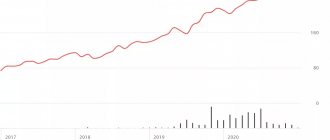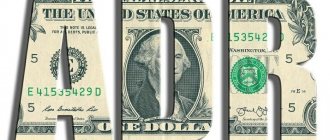A depositary receipt is a derivative financial instrument that allows you to invest and receive dividends on shares of non-resident companies whose entry into foreign markets is hindered by legislative restrictions, exchange listing requirements or regulatory authorities.
Depositary receipt is a derivative financial instrument that gives the right to receive income (but not the right to vote) on foreign securities transferred by the issuer to secure them for temporary storage in a custodian bank or depository bank. The current value changes synchronously with the quote of the underlying share, excluding possible exchange rate differences and legal restrictions.
The basic definition can be simplified: through the mechanism of depositary receipts (DRs), one can receive income from non-resident securities held in the depository bank as collateral. Receipts can be traded on all exchange and over-the-counter markets with the exception of the issuer's country.
The process is shown schematically in the figure:
1 Basic requirement for release initiators:
- DR security shares must not be pledged or otherwise encumbered and cannot be sold or transferred to another owner other than the depository during the entire term of the agreement;
2 Custodian bank (custodian bank):
- ensures the transfer of dividends;
- acts as a nominee holder to ensure liquidity of DRs;
- keeps records of the owners of the DR and the transfer of ownership;
3 Depository bank:
- can perform all the functions of a custodian;
- advises issuers in preparing the necessary documents and, on their behalf, submits the required reporting to regulatory authorities;
- provides primary information support to underriders before the start of DR placement on the stock exchange and among private investors;
4 Underrider:
- searches for initial buyers;
- collection and execution of subsequent orders for the purchase or sale of DR;
5 Investor:
- recipient of dividends and ultimate owner of receipts;
What is this in simple words?
To make it clear, let's look at an example. A person wants to invest money in shares of a foreign corporation. But they are traded on a different exchange, and not where the investor is used to working. Therefore, he acquires a depositary receipt, which confirms his rights to these shares. However, all privileges when using depositary receipts are retained: for example, dividends and votes at meetings. It turns out that a depositary receipt is almost the same thing, only in different words. Although there are still differences.
Receipts come in different denominations, which depend on the number of shares. The denomination is set by the exchange. One receipt can contain 1000 shares or even 0.1. Dividends are paid based on the number of shares. For example, if the payment amount is 50 rubles, and the receipt contains 2 shares, then the investor will receive 100 rubles. Foreign bonds are also bought in the same way, but they are not in great demand.
Sometimes the price of shares and depositary receipts differs. This happens due to the fact that different countries may react differently to any political situations, exchange rates, market dynamics and other factors.
For example, let’s take a Russian company whose revenue grows by 30%. Russian investors will see only positive results. At the same time, the ruble exchange rate could fall by 40%. Then foreign traders will see a loss. But some speculators make money from this price difference.
Types of AR and their features
Since depositary receipts are classified as securities, regulators impose a number of requirements on them. Depending on this, as well as other criteria, DR can be divided into several types.
Classification by geography
This instrument is created for a specific market. Depending on this, they distinguish:
- ADR– American depositary receipts
. A good example is Sberbank, whose securities can be bought on the London Stock Exchange, but it is not the securities that are traded directly, but ADRs. Moreover, each receipt corresponds to 4 ordinary shares. Without this scheme, Sberbank shares would not be available on the London Stock Exchange; - GDR
– global depositary receipts. They are created so that non-resident companies can enter the European market; most often, GDRs are traded on the platforms of several European countries. This is a younger tool compared to ADR. For example, on Börse Frankfurt not only shares of German and other companies are traded, but also GDRs for shares of Mail.Ru Group Ltd. Without this tool, traders working on the Frankfurt Stock Exchange would have to register with brokers with access to the MICEX to invest in Mail.ru securities. This is inconvenient and, most likely, no one in Germany would get involved with these shares; - JDR - Japanese DR. For the first time, Citibank and Mitsubishi UFJ Trust and Banking Corporation (a division of a larger structure called Mitsubishi UFJ Financial Group) were created;
- RDR is a specific instrument that first appeared in 2010. The first Russian issuer of depository receipts was Sberbank of Russia; it issued receipts for Rusal securities, which at that time were traded both in the Russian Federation and on the Hong Kong market. An agreement was concluded with Sberbank of Russia and RDRs were issued, each of which corresponded to 10 ordinary shares of Rusal. True, the demand for these DRs was low and as of August 10, 2022, the RDR issuance program was closed, Sberbank stopped issuing and repaying them;
- EDR – European depositary receipts. Citibank and Paris Stock Exchange participated in the development, the tool was created for European countries.
Both the company's securities and DRs for the same shares can be traded on exchanges at the same time. A similar situation occurred on the MICEX, when both Rusal shares and depositary receipts for them were traded there. But depositary receipts were issued for shares traded on HKEX.
I also recommend reading:
Debt/Ebitda multiplier (ratio of debt to EBITDA) - overview, how to use in analysis
Debt to EBITDA is one of the main multiples used when selecting stocks for an investment portfolio. This indicator is […]
Types of AR
The entire array of these securities can be divided into 2 categories:
- sponsored - their issue is initiated by the issuer of shares, that is, the company itself;
- unsponsored - they can be issued not only by the company, but also by the banks themselves or large shareholders. This type of ADR is convenient due to the lenient requirements from the SEC, but can only be issued on securities already traded on exchanges. They can only be purchased on the OTC market; they are not allowed on exchanges.
If ADRs are listed on any US exchange, they are classified as sponsored by default. The type of security is also indicated in the description of the security.
Sponsored ADRs are divided into subtypes depending on what SEC requirements the issuer meets:
- I level – the most lenient requirements from the SEC. Such ADRs are issued only on securities already in circulation. They cannot be traded on stock exchanges; companies use them to increase liquidity. The main relaxation of the requirements compared to higher types is the absence of the need to file a report in accordance with American generally accepted accounting principles (US GAAP);
- Level II – US GAAP reporting is submitted. Securities of this type are allowed to be listed on stock exchanges, but they are issued only for shares in circulation;
- Level III is the highest level among public ADRs; they can be issued for shares sold at an IPO and for outstanding securities. This is the most expensive and most difficult path, but you can quickly attract capital;
- 144A rule – ADR issuance programs that comply with this rule are called private. The securities are not available to everyone and are distributed among a narrow circle of qualified investors. They got their name because of the need to comply with Rule 144A. This rule relaxes the provisions of the Securities Act, enacted in 1933, regarding the holding period of securities by qualified investors. This rule also removes the requirement to register with the SEC.
I also recommend reading:
Assessing the effectiveness of investments - 4 criteria + formulas for calculation
Any investment is made with the aim of making a profit in the future, but assessing the effectiveness of investments cannot be reduced to simply calculating profit […]
Second-level ADRs are rarely used; from a cost point of view, this is an unprofitable option. The requirements are essentially the same as at Level 3, but cannot be issued for shares sold at an IPO.
Story
The history of depositary receipts began in the United States in 1927. Interest rates were low, so many investors decided to invest some of their money in foreign companies in developing countries. But a problem arose. The British stock exchange has banned the sale of shares to foreigners. Then in the USA they came up with this new type of securities. Shares do not leave country borders, but they can be traded.
Other causes of DR include the following. The excessive financial costs required to allow the issue of shares in other countries is the reason why companies prefer to list their shares for trading abroad through DR, which is comparatively cheaper.
How to effectively receive dividends, grow capital and not spend a lot of time on it? Watch the webinar in the recording “Strategies for investing in dividend stocks”
Global Depositary Receipt (GDR)
Simultaneously placed in several countries, but in one currency. They appeared in the 90s as a tool for raising capital by transnational companies simultaneously on American, European and Asian stock exchanges. Transactions are carried out on the exchange and over-the-counter markets, as well as through international clearing houses such as Euroclear and CEDEL.
The nominal value of a GDR can be equivalent to one, several or part of a share. They have no advantages over ADR, so at the moment they are almost never produced.
Mechanics
That is, a depository receipt is a secondary security that allows you to circumvent the ban on investing in securities of foreign companies. DRs provide all the rights of the underlying assets while remaining in the status of domestic securities.
The process of creating receipts is quite simple. First, custodian banks are selected that will store and issue DRs. Although sometimes one bank does this. Then they issue as many receipts as are required at the moment. The underwriting bank is responsible for their distribution. And only then they are acquired by an investor who, together with the receipt, acquires the right to exchange it for the corresponding amount of securities at any time.
Layout of depositary receipts
Shares are usually bought from one owner and sold to another. To do this, the trader gives an order to the broker. It’s the same with AR, but there are more ways:
- The broker buys receipts through its branches in other countries.
- Buys from other brokers who operate in the desired countries.
- If there are no ready receipts, the broker obliges the bank to issue new ones.
Looking for a good broker? Check out these:
Selling DR occurs in reverse order. If there is no one willing to purchase them, the receipts may be destroyed. But the investor will receive his money, because this will not affect the shares.
Dividends and taxation
Both American, global and Russian depositary receipts do not limit the owner in dividends. Owning DRs from the company's point of view is the same as owning shares, so all DR holders also receive dividends. The only thing that needs to be taken into account is the number of shares per DR. Dividends are always paid in foreign currency or rubles per share; further recalculation will have to be done independently.
For example, GDRs for shares of TCS Group Holding are traded on the MICEX. Each GDR corresponds to 1 share, which means that when dividends are paid, the holder will receive $0.21 (interim dividends in 2022) per share.
How many securities are included in 1 DR is indicated in the description of the instrument on the exchange where it is traded. The broker should have the same information.
As for taxation, if a broker is a tax agent, then when working with DR, he himself pays taxes for you . However, in the case of dividends on ADRs, you will have to pay tax on them yourself, fill out the 3rd personal income tax return and contact the tax office. In paragraph 2 of Art. 275 of the Tax Code of the Russian Federation states that in the case of payment of income by a Russian issuer of DR, the taxpayer must calculate the amount of personal income tax himself.
Types of depository receipts
Issuing DRs requires a large and stable stock market. There are several of them, so receipts are divided by country. Despite this, their release is carried out according to the same rules. Everyone remains in the black. Business attracts foreign capital, and investors have the opportunity to buy shares of large global corporations. The most popular are American and global DR, although there are many others.
ADR and GDR
American (ADR)
Since the United States was the first to introduce this new financial instrument, it was American receipts or ADRs that became the most widespread. They are issued by 3 banks for shares of the world's largest and most famous companies:
- Citigroup
- Morgan Stanley
- Bank of New York.
Organization of the issue of American Depositary Receipts
All ADRs are divided into 6 types:
- Unsponsored . This type is not available on official exchanges. Their issue was proposed by shareholders. Therefore, they are created only for those shares that have already entered into circulation on the market.
- Sponsored . The issue was offered by the issuer. They can be created for any shares: new and in circulation.
- First level ADR . Such shares are not traded on the stock exchange. But almost all Russian companies are gathered here.
- Second level ADR . They can already participate in stock trading if they meet the requirements. At the moment these are only 3 Russian ones, MTS and Wimm-Bill-Dann.
- Third level ADR . The most stringent conditions. Both shares and receipts must be registered in the states.
- Private receipts . Only investors with special qualifications can buy them.
What do these levels give? Firstly, the higher they are, the greater the liquidity and the lower the risks. Secondly, reliability depends on the level.
It is very profitable for companies to work with ADRs. They not only attract new investors, but also increase awareness in the United States and throughout the world. Usually, after the creation of receipts, shares quickly increase in price. There are also some advantages for investors. After all, ADRs for the American market are quite cheap. This is a great chance to make money from the largest corporations in the world.
For example, MTS, Mechel and Gazprom are listed on the New York stock exchange. Their depositary bank is the Bank of New York. An ADR corresponds to two shares of one of these companies.
You can view all episodes of American DR here
Russian (RDR)
It is difficult, and usually completely impossible, for Russian residents to buy ADRs. Therefore, it is better to work with this financial instrument through Russian depositary receipts or RDRs.
The underlying asset of Russian depositary receipts can be foreign shares and bonds. RDRs have existed relatively recently, but they have not managed to advance in the market.
According to Article 27.5-3 of Federal Law No. 39, the issuer of Russian depositary receipts is a depositary created in accordance with the legislation of the Russian Federation.
The depository here is Sberbank, and the issuer of the underlying asset is United Company Rusal Plc. You can buy them at Sberbank or at the Moscow Exchange.
Global (GDR)
Despite the name, these receipts are presented on only six world exchanges. London is considered the most important. The GDR appeared a little later than the ADR, but they are very similar to them. They attract investors with low prices. GDRs are sometimes even cheaper than shares.
An example can be given. Its shares cost about 150 rubles, and GDRs cost 30 rubles. Its depository bank is Deutsche Bank. But Tinkoff shares cost the same as GDRs. Their depository bank is JPMorgan Chase.
If we talk about foreign shares, then when buying, the commission on them is usually higher. Because of these advantages, GDRs are often chosen by investors. The largest depository banks are located in the USA and Europe. Among them we can highlight:
- Deutsche Bank;
- JPMorgan Chase;
- Bank of New York;
Some companies from Russia do not even want to start trading on the Moscow Exchange. Therefore, they immediately switch to global depositary receipts. This is because they want to raise more capital since GDRs are very liquid. They are also divided according to the form of release into sponsored and unsponsored.
European (EDR)
Typically, EDRs are traded in the same countries where they were issued. The currency here is often the euro, although dollars are also common. The EDR is issued by Citibank jointly with the Paris Stock Exchange. They resemble American Depositary Receipts because they are traded on one market - the European one. Just not common enough. Traded in the special Euroclear system.
Most SDRs can be found on the London and Luxembourg stock exchanges.
Kinds
Depository receipts are divided into types according to the place of issue and circulation:
- American;
- global;
- Russian;
- European;
- other.
The first three types are of interest to Russian investors. Moreover, the first ones - ADRs - are circulated not only within the United States.
American, or ADR
ADRs are issued by American investment banks and are denominated in US dollars.
These depository receipts are divided into several types:
- Unsponsored ADRs. These receipts are issued by a depositary bank without concluding a written agreement with a foreign company and are traded through over-the-counter transactions in the relevant US market. They differ from the rest by poor liquidity and excessive risk borne by the acquirer.
- ADR I. Lowest level. Issued on securities of companies that submit minimum reports. In fact, they are only quoted on over-the-counter markets.
- ADR II. This is already a level that gives depositary receipts access to the NYSE, AMEX, NASDAQ. ADR II issuers are required to be licensed by the US Securities and Exchange Commission (SEC) and to publish reports in accordance with its standards and annual accounting reports.
- ADR III. This is actually the same as stock trading, since it obliges the depositary bank to register the foreign issuer's primary securities with the SEC along with the receipts themselves. Corresponding requirements apply to the publication of reporting by a foreign business entity, which must be quarterly.
The higher the ADR level, the more liquid the security and the less risky the investment.
Global GDRs
GDRs are depositary receipts with turnover in a number of countries, de facto predominantly European. The London Stock Exchange is famous for the largest trading volume of GDRs. This is also where the purchase and sale of most GDRs on primary securities of Russian companies takes place.
Russian RDRs
The domestic analogue of ADR/GDR was first released in 2007. Payments of dividends on Russian depositary receipts are actually made in rubles, although theoretically they are allowed in world currencies.
State registration of RDRs and supervision of depository banks is carried out by the Central Bank of the Russian Federation. Those, in turn, must publish information about foreign securities for which they issue depositary receipts.
Today, RDRs are not in demand and are practically not issued; only the RUSAL company, registered on one of the islands of Great Britain and an issuer of shares traded on the Hong Kong Stock Exchange, has reached an agreement with Sberbank on the issue of RDRs.
Receipts for RUSAL shares have been listed on the Moscow Exchange, where they can be bought or sold through a broker.
Examples with photos
In modern reality, you can buy and sell depository receipts electronically, but there are also paper ones. Below are preserved photographs of DRs of famous companies.
DR by Trump Hotel and Casino Resort Inc
DR from MOET Hennessy Louis Vuitton
Microsoft DR
DR Sony Corp.
DR of Lukoil company
Strengths and weaknesses of working with depository receipts
For convenience, we will make a comparison in tabular form.
| Advantages | Flaws |
| 1. Possibility of portfolio diversification. Investors can buy shares of companies from any country. 2. Investors receive dividends and voting rights . Owning DR is practically the same as owning shares. 3. Buying DR is more convenient, simpler and cheaper (less commissions). 4. This tool makes it easier to raise capital. | 1. Relatively low liquidity. DRs are not always suitable for active trading. 2. DR can be revoked . The refund period is not immediate; the money will be frozen for some time. 3. The price of the receipt depends on the price of the share ; there are risks of a decline in quotes, for example, due to a poor quarterly report or a worsening state of the global economy. 4. Currency risk - if dividends are converted into another currency, this occurs at the rate specified in the deposit agreement. When the exchange rate changes, the investor may lose money due to this. |
Difference between shares and depositary receipts
In simple terms, shares can be called a share in a company, and DR - rights to a share.
As for reliability, it does not make much difference for an investor in what securities to invest in, be it shares or DR. Some states prohibit the transfer of shares outside the country. But when a company wants to raise new money, it creates a depository receipt. Buying and selling depositary receipts for an investor is not much different from transactions with shares. On the stock exchange, these financial instruments look the same.
The only significant difference can be considered tax deductions. The fact is that you can use an individual investment account (IIA) only on Russian exchanges. You can use a brokerage account, for example, to purchase ADRs, but then there will be no tax deductions. And do not forget that ADR is a foreign financial instrument. Ask your broker for more details.
In some cases, the price of DRs and shares may differ. This is due to different reactions of countries to certain situations. Liquidity also plays a role. Stocks are bought and sold much more frequently. Sometimes the difference is quite significant, even if you do not take into account the exchange rate.
Is it worth investing?
For a Russian, purchasing DR is the only way to invest in companies whose shares cannot be purchased even through foreign brokers.
If such a company demonstrates excellent financial health, is a blue chip, and generously pays dividends to private investors, then it is definitely worth taking ADR/GDR.
Advantages and disadvantages of investing in AR
Now let’s traditionally weigh the pros and cons of an investment instrument. Its attractiveness is ensured by:
- Convenience of purchasing primary securities of foreign issuers through DR.
- The simplicity of trading derivative securities of the appropriate level on the exchange, which allows you to freely speculate on them and provides ample opportunities to make a profit.
- Lower depository costs compared to purchasing “primary” from foreign brokers.
- The opportunity to invest in domestic ones, which are not available on the MB.
The main disadvantage of investing in ADR/GDR by purchasing through a Russian broker is the lack of scope for speculation, since in the domestic depositary system the transfer of ownership of foreign receipts often drags on for several days.
Another disadvantage is that the tax agent, who is the issuer of depositary receipts, often charges inflated amounts of fiscal payments.
Pros and cons when using
For investors, one of the main advantages is buying foreign shares on their familiar exchange. There is no need to exchange money for the currency of the country where the selected company is located. And the law may prohibit buying shares directly. By the way, in some countries there are restrictions on the participation of foreign traders in trading. With the help of AR, these problems can be easily solved. Access to highly profitable companies opens up.
In addition, sometimes receipts are cheaper than shares, and buying them is just as easy. If we talk about Russian investors who want to buy DRs of domestic companies on foreign exchanges, they have additional insurance. After all, they will buy in dollars or euros. And dividends will also be paid in foreign currency. And it is not necessary to indicate income from DR in tax reporting.
The disadvantages include unforeseen situations that sometimes arise in the market. For example, the rise or fall of the exchange rate. This also includes possible conflicts between countries. When this happens, the price of DR may decline. They are being sold at an accelerated pace by foreign investors. Not only receipts, but also shares.
Not all companies issue DRs, and not every broker has access to other exchanges.
Varieties
There are several types of AR. Depending on the issuing country, they are divided into the following groups:
American (ADR)
ADR is the oldest group of depositary receipts. They have been issued by US banks for shares of foreign companies since 1927. Banks are issuing:
- Morgan Stanley;
- Bank of New York;
- Citigroup.
ADRs are traded on the New York Stock Exchange and their value is expressed in dollars or euros. There are 2 types of ADR – sponsored and unsponsored. Unsponsored depositary receipts are traded on the over-the-counter market and are issued for those securities that are already in circulation. Such ADRs are characterized by a high level of risk.
We'll talk more about sponsored ADRs below. The initiator of their issue is the issuer. Such depository receipts can be issued either immediately after the issue of shares or for existing securities.
European (EDR)
Issuers of European depositary receipts are banks in European countries. Certificates are issued in dollars and euros. For a European investor purchasing DRs on US stocks, there is currency risk. Therefore, you need to monitor the quotes of the EUR/USD pair.
Reference materials (download)
| # | File | file size |
| 1 | Test work Depository receipts | 48 KB |
| 2 | Article. Depository receipts, conversion rate 2014 | 264 KB |
| 3 | Questionnaire of the depository - issuer of Russian depositary receipts (sample) | 1 MB |
| 4 | Federal Law of April 22, 1996 N 39-FZ (as amended on December 27, 2019) “On the Securities Market” | 2 MB |










